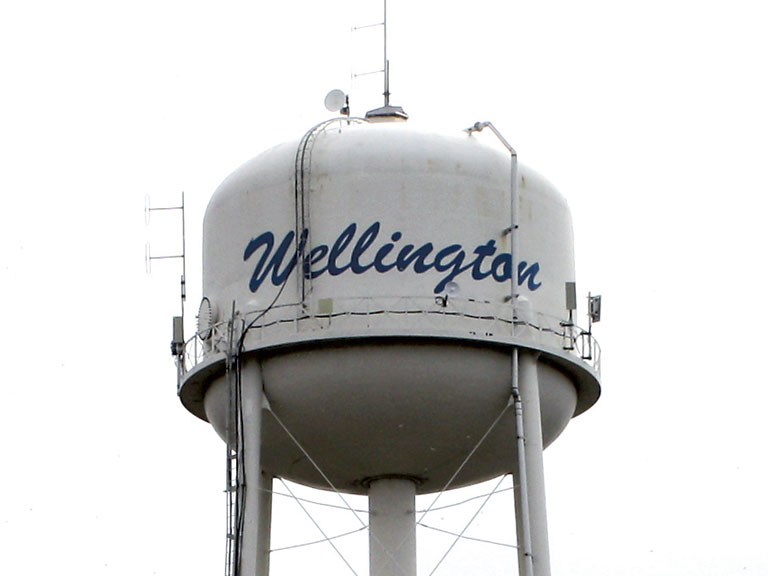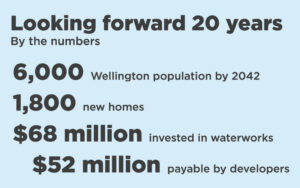County News
Growing pains

County staff address questions from nervous waterworks customers and village residents
Shire Hall anticipates more than 200 new homes to sprout from the ground in Wellington next year. It is a big jump. The last year in which the entire municipality issued more than 200 new home building permits was 18 years ago. Wellington currently sees an average of 30 new homes built each year.
The predicted spike in residential growth is just the beginning. The County expects new home building in the village to continue at a 200-homes-a-year clip until a new bigger and better waterworks capacity is constructed by 2024. After which, it sees the pace of new home construction rising to more than 300 units per year.
The County figures it needs to invest about $70 million upgrading and building capacity into the village waterworks to make this work. This means a new water tower, new water and sewer trunk lines under the Millennium Trail, as well as new plants to process the additional water and wastewater needs.
According to County officials, its homebuilding projections are supported by developers who are ready to spend money now to prepare the land for their project’s infrastructure needs—pipes, cabling, roads etc. Crucially, these builders are further prepared to help finance the County’s infrastructure costs— specifically, a portion of these costs that would typically be recovered from the developer over time as each house is begun.
If it works, this arrangement could limit the risk to the County’s waterworks utility. Rather than waiting for development charges—the fees charged to builders to expand infrastructure as well as police and fire services, libraries, community centres, and such—to trickle in, the developers commit these fees upfront. In exchange, developers gain some certainty regarding when the infrastructure will be in place and when they can begin to sell homes. Time is money.
As in any endeavour of this scale, of course, the devil is in the details. And many of the details have yet to be finalized.
Four Shire Hall officials hosted an online information session last week—available for viewing here—described as the ‘beginning of the conversation.’ Together they outlined the growing demand for homes in the County, how new residential growth will help to pay for the County’s infrastructure renewal, and how upfront financing might benefit existing waterworks customers as well as mitigating the risk of this big investment.
 They also answered questions from residents—many of which centred on assumptions in the Wellington Master Servicing Plan (MSP). Prepared by an engineering consultancy in 2019, the plan describes, in concept, what will be needed to ensure the village’s waterworks can accommodate a population increase from 2,189 to 8,600.
They also answered questions from residents—many of which centred on assumptions in the Wellington Master Servicing Plan (MSP). Prepared by an engineering consultancy in 2019, the plan describes, in concept, what will be needed to ensure the village’s waterworks can accommodate a population increase from 2,189 to 8,600.
Several folks wanted to know why, and upon what basis, the municipality and its consultant were contemplating such a massive expansion. After all, the village’s secondary plan—finalized just six years ago—imagined a population increase of just 3,080 new folks in its most aggressive of three scenarios. Others wanted to know who would be on the hook to fund the $70 million debt and maintain the unused capacity if the market fizzled—if it failed to attract 6,400 more folks to live here. Then there are some who would rather not see mass residential development— at least not on this scale—in this village.
County officials pointed to Wellington’s secondary plan, which expands the geographic area of the village beyond the Millennium Trail northward to a line roughly drawn by extending Gilead Road westerly past Consecon Street. It is a very large area. Significantly larger than the existing settlement area.
County officials suggested the scale of the waterworks infrastructure expansion was triggered by the area that might one day require servicing. According to the MSP, this will cost about $100 million.
The County’s works chief Peter Moyer explained that while this was the big conceptual picture, his team is focused on a 20-year horizon of residential expansion. According to a report prepared earlier this year, this timeframe contemplates a swelling of the village population from 2,189 to 6,000 by 2042. This means about 1,800 new homes over two decades.
To accommodate this growth, Moyer said the utility must spend about $68 million on Wellington’s waterworks over the next three years.
QUESTIONS AND ANSWERS
But what if buyers fail to show up to purchase hundreds of new homes in Wellington? There is unquestionably intense demand pressure for new homes in the village. But how much? And for how long? Markets change. Lending rates change.
In that event, existing water users across the County would be on the hook for the outstanding debt resulting from the waterworks expansion in Wellington as well as maintaining the unused capacity.
To offset this risk, Shire Hall is seeking commitments from developers to finance the growth-related costs in advance of expanding Wellington’s waterworks. According to Moyer’s presentation, the developer’s share (of $68 million to be spent over the next three years) is about $52 million. (The balance, about $16 million, would be spent on upgrading the system that accord to existing waterworks users.)
These commitments will be secured by Letters of Credit—a form of financial security that binds payment when certain conditions are met. While details of how much financial exposure will be covered in this way were not provided, County officials said more information would be forthcoming in its report to council on April 29.
Municipal planners are also relying on the phasing of development to help manage the risk.
“Construction can be broken down into phases,” said CAO Marcia Wallace, in a follow- up email. “First the new elevated tower with the trunk mains, EQ [equalization] tank at the wastewater treatment plant and EAs [environmental assessments] for the plants with estimated costs of $25.9 million of which $20.2 million is recoverable through development charges. If there is still development interest, the County would then move forward with the construction of the new plants at an estimate of $41.6 million, of which $32.3 million is recoverable through development charges.”
CAO Wallace says it is not an all-or-nothing exercise.
“The important part is to have foresight and plan for it and not block our future possibilities with what we’re building today. It doesn’t mean everything needs to be built today.”
WHY GROW?
The County’s finance director, Amanda Carter, explained that residential growth drives much needed new revenue in the form of assessment growth (more property taxpayers), development charges (offsetting the costs of infrastructure as well as other services including police, ambulance and recreation) and user fees (waterworks, garbage, planning etc.). Broadly speaking, every new home in the County creates a new property taxpayer, who then helps to pay for roads, bridges, parks, arenas and such. Similarly, every new home constructed in an area served by municipal waterworks becomes a new customer of the utility. They provide an immediate benefit to existing users since they distribute the cost of the system across more customers.
Development charges are designed to ensure that only new homeowners pay for the expansion of infrastructure and other services needed to accommodate them. It is a precise and highly regulated calculation that is meant to confirm growth pays for growth and existing users pay only for the improvements required to maintain the existing capacity. A revised development charges study—area rated for Wellington only— is set to be presented to council on April 29.
User fees, in the waterworks context, come in the form of your bi-monthly water bills. More customers mean more people to pay the fixed costs of running plants and maintaining the pipes and pumps. This is critical because County waterworks customers spend a large portion of their bill on base charges (a bit more than half). Spreading the base charge over more users means customers not only benefit from distributed costs but also gain more control over the size of their water bills.
For example, residents are often surprised when they return from their winter residences to find a water bill indicating they owe hundreds of dollars even though they haven’t used a drop in months. This is because it costs money to keep the system working when they are away. Adding more users dilutes the base charge—all other factors remaining equal. This means that the amount of water you consume has a more direct relationship to your bill.
WHY SO FAST?
This question wasn’t answered directly during the information session. There may be answers in the development charges study being presented to Council on April 29. It is critical, however, that this community understand the mechanics and pressures—internal and external—driving this pace of growth before these plans are baked in.
USER PARTICIPATION
CAO Wallace appeared to throw cold water on the notion that waterworks customers might gain more direct involvement in the decision-making. The CAO said the municipality was working from the findings of a former ad hoc committee that looked at the waterworks system over a couple of years. Moreover, she added that Shire Hall was bolstered by the support of its economic consultants and legal advisors.
“We didn’t see the need to bring another committee together,” explained Wallace. “Our attempt is for a wider, transparent conversation. Because it isn’t just about rates or how much you pay for your water, it is about growth and how it is changing the community. The decision rests with council.”
This is unlikely to assuage Wellington residents facing the prospect of rapid expansion of their village. It is a situation made more awkward since at least a third of council members—the ostensible governors of the utility— are not customers. It doesn’t mean these representatives don’t care about Wellington’s waterworks customers, but it does mean their interests aren’t aligned with the folks who must pay for this system.
In any event, next month, the County will host a virtual consultation to review the interim control by-law that has put a hold on further development proposals in the village over the past year. That session will be held online on May 12 from 7:30 to 8:30 p.m. A continuation of the conversation.

Comments (0)